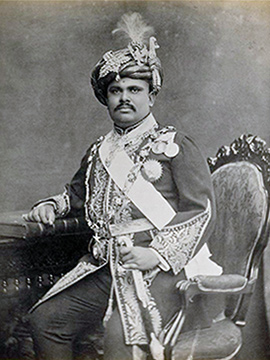Takhtsinhji facts for kids
Quick facts for kids Takhtsinhji |
|
|---|---|
| Maharaja Raol Sir Takhtsinhji Jaswantsinhji | |
 |
|
| Reign | 1870 to 1896 |
| Born | 6 January 1858 |
| Died | 29 January 1896 (aged 38) |
| Father | Jaswantsinhji |
Maharaja Raol Sir Takhtsinhji Jaswantsinhji (born January 6, 1858 – died January 29, 1896) was a very important ruler, known as the Maharaja, of a place called Bhavnagar. He belonged to the Gohil clan, a group of Rajput chiefs. He became the ruler of Bhavnagar state in Kathiawar in 1870, after his father, Jaswantsinhji, passed away.
Contents
Life and Rule
Early Life and Education
Takhtsinhji became the ruler of Bhavnagar in 1870. He was still young at the time. He went to the Rajkumar College, Rajkot, which was a special school for princes. He was actually the very first student there! After finishing school in 1878, he continued his studies with an English officer.
While he was still young, the state was managed by two important people. One was Mr. E. H. Percival, who was part of the Indian Civil Service. The other was Gaurishankar Udayshankar, a very smart Indian statesman. They helped run Bhavnagar until Takhtsinhji was old enough to rule on his own.
Modernizing Bhavnagar
When Takhtsinhji turned 20, he took full control of his territory. It was a large area, almost 3,000 square miles (about 7,770 square kilometers). One of his first big decisions was to build a railway line. This railway connected Bhavnagar to bigger train routes. It was a very new idea for a ruler in western India at that time!
The railway brought a lot of good things to Bhavnagar. It helped with trade and made the economy stronger. It also led to many social improvements. Takhtsinhji believed in making his state modern and progressive. He built more schools, hospitals, and medical centers. He also improved roads, built bridges, and put up beautiful new buildings.
New Ways of Governing
In 1886, Takhtsinhji started a new way of governing. He set up a "council of state" with four members. These members helped him manage different parts of the government. He was the head of this council. This was a very modern idea for the time and was supported by the governor of Bombay, Lord Reay.
This new system faced some challenges. Some people tried to spread false rumors about the Maharaja. Takhtsinhji took them to court, and the people who were trying to cause trouble were punished. This helped other rulers in India who were facing similar problems. People across India and the British government praised Takhtsinhji for his courage.
Visiting England and Honors
Takhtsinhji received many honors during his rule. He was given the Empress of India Gold Medal in 1877. In 1881, he was made a Knight Commander of the Order of the Star of India (KCSI). Later, in 1886, he was promoted to a Knight Grand Commander (GCSI).
In 1891, his family title of Thakur was officially changed to the higher title of Maharaja. In 1893, he traveled to England to visit Queen Victoria, who was the ruler of the British Empire. While he was there, the University of Cambridge gave him an honorary degree.
Supporting Education and Development
Takhtsinhji was a big supporter of education. Since he was the first student at Rajkumar College, Rajkot, he became its most important helper and supporter after he became Maharaja. He also helped other colleges like Gujarat College and Fergusson College. He supported schools for girls and women too.
In 1885, he started the Samaldas Arts College, naming it after Samaldas Mehta, who later became an important minister for the state. During his time as ruler, he worked hard to improve Bhavnagar. He made changes to how taxes were collected, built water systems, and created modern docks for ships. He also expanded medical care, built a port, and continued building bridges, hospitals, and schools.
Takhtsinhji was known as a "model ruler of a model state" because of all his good work. He passed away on January 29, 1896, at the age of 38. His oldest son, Bhavsinhji II, became the next Maharaja of Bhavnagar.
Titles and Awards
Takhtsinhji held several important titles and received many awards during his life:
- 1858–1870: Maharajkumar Shri Takhtsinhji Jaswantsinhji Sahib Gohil, Yuvraj Sahib of Bhavnagar (This means he was the Crown Prince of Bhavnagar.)
- 1870–1877: His Highness Maharaj Raol Shri Takhtsinhji Jaswantsinhji Sahib, Maharaj Raol Thakore Sahib of Bhavnagar
- 1877–1881: His Highness Maharaj Raol Shri Takhtsinhji Jaswantsinhji Sahib, Maharaj Raol Thakore Sahib of Bhavnagar, KIH
- 1881–1886: His Highness Maharaj Raol Shri Sir Takhtsinhji Jaswantsinhji Sahib, Maharaj Raol Thakore Sahib of Bhavnagar, KCSI, KIH (KCSI means Knight Commander of the Star of India.)
- 1886–1891: His Highness Maharaj Raol Shri Sir Takhtsinhji Jaswantsinhji Sahib, Maharaj Raol Thakore Sahib of Bhavnagar, GCSI, KIH (GCSI means Knight Grand Commander of the Star of India, a higher honor.)
- 1891: He was given the personal title of Maharaja.
Honors Received
- Prince of Wales gold medal: 1875
- Empress of India Gold Medal: 1877
- Knight Grand Commander of the Order of the Star of India (GCSI): 1886 (He was first made a KCSI in 1881.)
- Personal title of Maharaja: 1891

